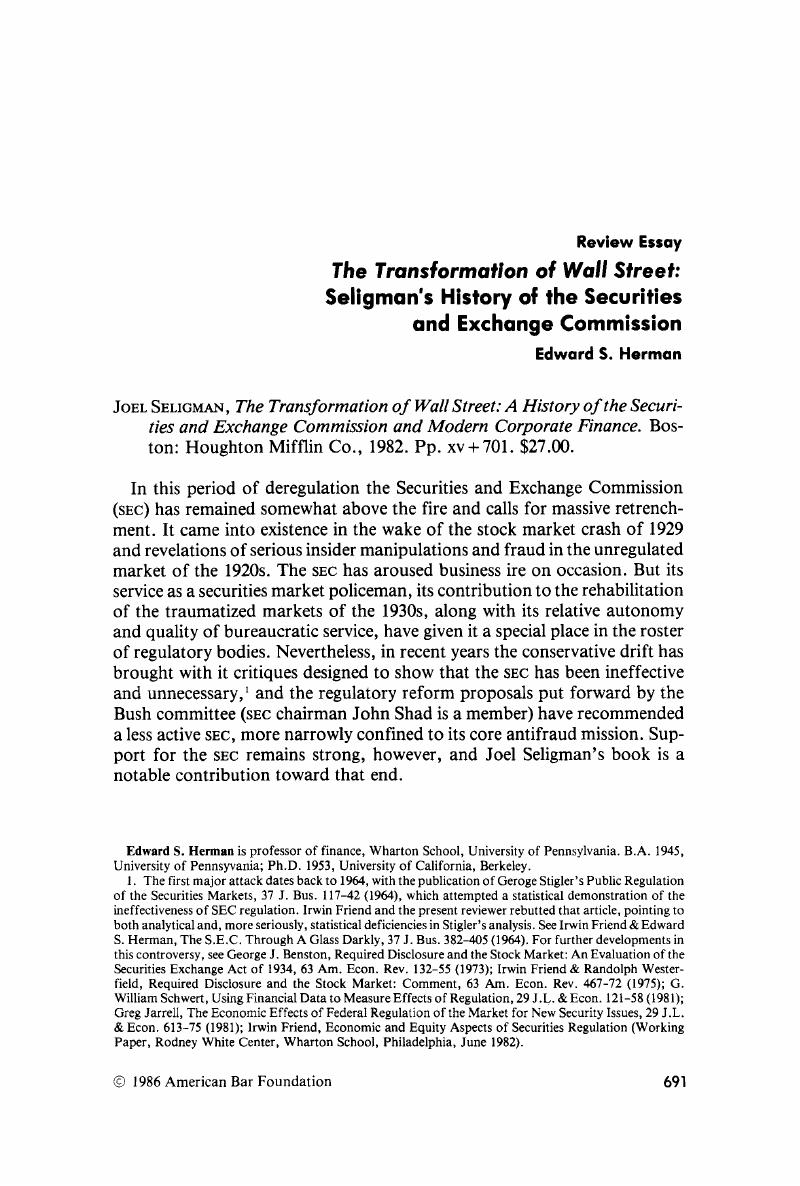No CrossRef data available.
Article contents
The Transformation of Wall Street: Seligman's History of the Securities and Exchange Commission
Published online by Cambridge University Press: 20 November 2018
Abstract

- Type
- Review Essays
- Information
- Copyright
- Copyright © American Bar Foundation, 1985
References
1 The first major attack dates back to 1964, with the publication of Stigler's, Geroge Public Regulation of the Securities Markets, 37 J. Bus. 117–42 (1964), which attempted a statistical demonstration of the ineffectiveness of SEC regulation. Irwin Friend and the present reviewer rebutted that article, pointing to both analytical and, more seriously, statistical deficiencies in Stigler's analysis. See Friend, Irwin & Herman, Edward S., The S.E.C. Through A Glass Darkly, 37 J. Bus. 382–405 (1964). For further developments in this controversy, see Benston, George J., Required Disclosure and the Stock Market: An Evaluation of the Securities Exchange Act of 1934, 63 Am. Econ. Rev. 132–55 (1973); Irwin Friend & Randolph Westerfield, Required Disclosure and the Stock Market: Comment, 63 Am. Econ. Rev. 467–72 (1975); G. William Schwert, Using Financial Data to Measure Effects of Regulation, 29 J.L. & Econ. 121–58 (1981); Greg Jarrell, The Economic Effects of Federal Regulation of the Market for New Security Issues, 29 J.L. & Econ. 613–75 (1981); Irwin Friend, Economic and Equity Aspects of Securities Regulation (Working Paper, Rodney White Center, Wharton School, Philadelphia, June 1982).CrossRefGoogle Scholar
2 “The principal actor in this transformation of corporate finance has been the Securities and Exchange Commission” (at x).Google Scholar
3 For a statement to this effect, and further citations, see 2 Alfred Kahn, The Economics of Regulation: Principles and Institutions 73 (New York: John Wiley & Sons, 1971).Google Scholar
4 Seligman had been a co-author with Ralph Nader and Mark Green of a 1976 volume entitled Taming the Giant Corporation. Despite his expression of partial approval, Kripke did go on to make some serious criticisms of the book. See 59 N.Y.U.L. Rev. 230 (1984).Google Scholar
5 Depression levels of unemployment also contributed to this availability; and some agencies like the SEC also benefited from the progressive tenor of the times and the idealistic desire to be associated with a beneficial cause. See Auerbach, Jerold S., Unequal Justice: Lawyers and Social Change in Modern America (New York: Oxford University Press, 1976), esp. ch. 6, “A Great State Service.”.Google Scholar
6 Report of the Comm. on Interstate and Foreign Commerce, H.R. Rep. No. 2337, 89th Cong., 2d Sess. (Dec. 2, 1966).Google Scholar
7 Report of the Special Study of the Securities Markets of the Securities and Exchange Commission, H.R. Doc. No. 95, 88th Cong., 1st Sess. (1963).Google Scholar
8 Seligman Wisely selects for quotation Professor George Benston's classic remark in defense of disclosure conditions in the 1920s: “If management believed that the marginal revenue to the stockholders as a group from disclosure would exceed the marginal cost of preparing and supplying the information, they would disclose their financial and other data” (at 564). This brings Dr. Pangloss into the twentieth century with what we may call a “hard” version of the Agency Model of corporate governance.Google Scholar
9 Cary's book, Politics and the Regulatory Agencies (New York: McGraw-Hill, 1967), is a somber work most notable for its impressive and pessimistic account of the difficulties faced by a regulatory body. In a sense it is the regulators' Book of the Dead.Google Scholar
10 For an application of a political-economic model to the history of the SEC, see Weingast, Barry, The Congressional-Bureaucratic System: A Principal Agent Perspective [with Applications to the SEC], Carnegie Papers on Political Economy, vol. 4, Supplement to 44 Pub. Choice 147–91 (1984). See also Keeler, Theodore, Theories of Regulation and the Deregulation Movement, Carnegie Papers on Political Economy, id. at 103–45.Google Scholar




